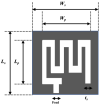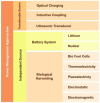Review on Medical Implantable Antenna Technology and Imminent Research Challenges
- PMID: 34063296
- PMCID: PMC8125567
- DOI: 10.3390/s21093163
Review on Medical Implantable Antenna Technology and Imminent Research Challenges
Abstract
Implantable antennas are mandatory to transfer data from implants to the external world wirelessly. Smart implants can be used to monitor and diagnose the medical conditions of the patient. The dispersion of the dielectric constant of the tissues and variability of organ structures of the human body absorb most of the antenna radiation. Consequently, implanting an antenna inside the human body is a very challenging task. The design of the antenna is required to fulfill several conditions, such as miniaturization of the antenna dimension, biocompatibility, the satisfaction of the Specific Absorption Rate (SAR), and efficient radiation characteristics. The asymmetric hostile human body environment makes implant antenna technology even more challenging. This paper aims to summarize the recent implantable antenna technologies for medical applications and highlight the major research challenges. Also, it highlights the required technology and the frequency band, and the factors that can affect the radio frequency propagation through human body tissue. It includes a demonstration of a parametric literature investigation of the implantable antennas developed. Furthermore, fabrication and implantation methods of the antenna inside the human body are summarized elaborately. This extensive summary of the medical implantable antenna technology will help in understanding the prospects and challenges of this technology.
Keywords: antenna design; biocompatibility; implant fabrication; medical implantable antenna; specific absorption rate.
Conflict of interest statement
The authors declare no conflict of interest.
Figures






























Similar articles
-
Implantable antennas for biomedical applications: a systematic review.Biomed Eng Online. 2024 Aug 29;23(1):87. doi: 10.1186/s12938-024-01277-1. Biomed Eng Online. 2024. PMID: 39210335 Free PMC article.
-
Optimizing Cardiac Wireless Implant Communication: A Feasibility Study on Selecting the Frequency and Matching Medium.Sensors (Basel). 2023 Mar 24;23(7):3411. doi: 10.3390/s23073411. Sensors (Basel). 2023. PMID: 37050471 Free PMC article.
-
A Comprehensive Review of In-Body Biomedical Antennas: Design, Challenges and Applications.Micromachines (Basel). 2023 Jul 21;14(7):1472. doi: 10.3390/mi14071472. Micromachines (Basel). 2023. PMID: 37512782 Free PMC article. Review.
-
RF communication between dual band implantable and on body antennas for biotelemetry application.Sci Rep. 2025 Feb 3;15(1):4065. doi: 10.1038/s41598-025-86235-0. Sci Rep. 2025. PMID: 39900953 Free PMC article.
-
Miniaturised implantable circular polarized antenna with a high ARBW.PLoS One. 2025 May 7;20(5):e0321670. doi: 10.1371/journal.pone.0321670. eCollection 2025. PLoS One. 2025. PMID: 40333944 Free PMC article.
Cited by
-
An Ex Vivo Study of Wireless Linkage Distance between Implantable LC Resonance Sensor and External Readout Coil.Sensors (Basel). 2022 Nov 1;22(21):8402. doi: 10.3390/s22218402. Sensors (Basel). 2022. PMID: 36366097 Free PMC article.
-
Planar Elliptical Inductor Design for Wireless Implantable Medical Devices.Bioengineering (Basel). 2023 Jan 23;10(2):151. doi: 10.3390/bioengineering10020151. Bioengineering (Basel). 2023. PMID: 36829645 Free PMC article.
-
Comparative analysis of energy transfer mechanisms for neural implants.Front Neurosci. 2024 Jan 16;17:1320441. doi: 10.3389/fnins.2023.1320441. eCollection 2023. Front Neurosci. 2024. PMID: 38292898 Free PMC article. Review.
-
Design of a Novel Compact MICS Band PIFA Antenna for Implantable Biotelemetry Applications.Sensors (Basel). 2022 Oct 26;22(21):8182. doi: 10.3390/s22218182. Sensors (Basel). 2022. PMID: 36365880 Free PMC article.
-
Implantable antennas for biomedical applications: a systematic review.Biomed Eng Online. 2024 Aug 29;23(1):87. doi: 10.1186/s12938-024-01277-1. Biomed Eng Online. 2024. PMID: 39210335 Free PMC article.
References
-
- Merli F., Bolomey L., Zurcher J.-F., Corradini G., Meurville E., Skrivervik A.K. Design, realization and measurements of a miniature antenna for implantable wireless communication systems. IEEE Trans. Antennas Propag. 2011;59:3544–3555.
-
- Das R., Yoo H. A multiband antenna associating wireless monitoring and nonleaky wireless power transfer system for biomedical implants. IEEE Trans. Microw. Theory Tech. 2017;65:2485–2495. doi: 10.1109/TMTT.2017.2647945. - DOI
-
- Skrivervik A.K., Merli F. Design strategies for implantable antennas; Proceedings of the 2011 Loughborough Antennas & Propagation Conference; Loughborough, UK. 14–15 November 2011; pp. 1–5.
Publication types
MeSH terms
Grants and funding
LinkOut - more resources
Full Text Sources
Miscellaneous

